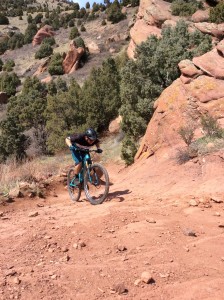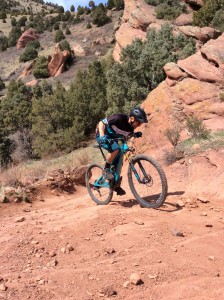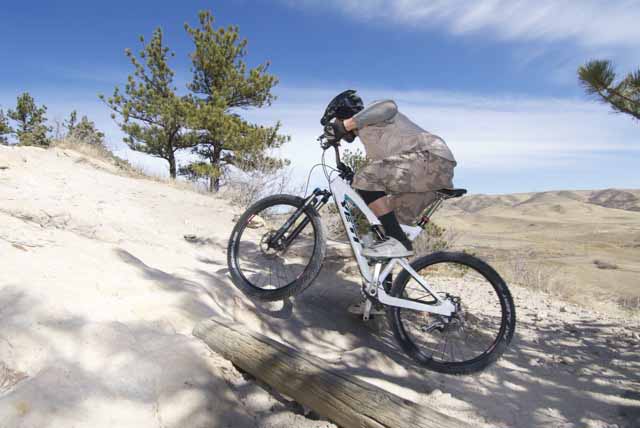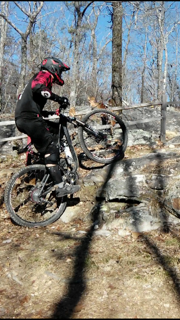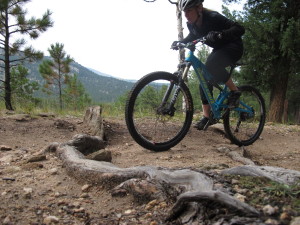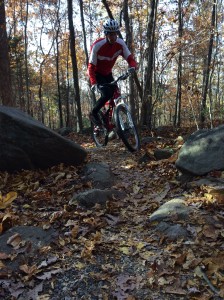Check out this video featuring many of today’s top professional Enduro and Downhill racers (and, yes, the following will apply to beginner, intermediate, etc., mtb riders):
Click on HERE for Video
Notice this: when things are going correctly, all of these riders have virtually no movement in their heads. Of course, they are moving down the track, but the momentum path of the head is smooth; there are no abrupt or jarring motions. Even when the bike is bouncing, pivoting, and sliding wildly, the head is moving through space in a calm and predictable manner, a smooth momentum path.
Enter the Glass o’ H20
In my MTB camps, I have students imagine that they have a glass of water duct taped to the top of their helmets. If they are doing things correctly while descending, this glass of water should not spill, it shouldn’t slosh around, the surface of the h20 should be calm and smooth. (Of course we don’t take this exactly literally. But after watching the video, you probably get the point.)
Keeping the head — or control center of the body — calm is essential to descending on a mountain bike well in tough terrain. This is true to all speed oriented sports (and, with very rare exception, all athletics); watch motocross and supercross racers in the rough stuff; watch downhill and mogul skiers…check out some slow motion footage of a cheetah chasing a gazelle through the Serengeti on National Geographic (Gazelle? Antelope? Whatever…the fast, scared thing with the horns).
In all of the above examples, the top athletes — and big cats — will have That Calm Glass of Water. There are many reasons why this is essential .
Really, the calm glass of water is a result of doing all the other things properly — or extremely close to properly — while descending on the bike: particularly, body position and especially weight placement/distribution.
Here’s Where Things Get Good!
I have never met a rider who has a complete understanding of descending position, or the “attack position,” on the bike (and almost no one understands what I like to call weight placement and/or line of force, two very essential elements of MTB technique when it comes to riding well). This includes world cup downhillers and pro enduro racers. Often, top riders are doing many things correctly or very close (you don’t ride that well without doing most things very well). But, because they are unaware of what these things actually are, it is very easy for riders — even at these levels — to develop bad habits, to train ineffectively, to communicate improper techniques to others, as well as not being able to replicate what they were doing properly, when they were on there game, once they inevitably fall of that game a bit. (Often, that’s when they come to me!)
In other words, they would stand a way better chance of staying fast and going faster if they knew what they really needed to work on. Following this logic, even in the areas where they are pretty good, even these top riders could certainly improve.
For less experienced riders, knowing what’s up with riding means being able to ride more difficult trails, keeping up with your buddies, developing control and confidence, being more efficient. These equate to being safer and faster, things we all want and need!
The Nuts and Bolts
The body is a kinetic chain. This couldn’t be more true when it comes to keeping the head balanced and stable while riding the bike (the Imaginary Glass of Water). If one area is off, that will permeate and reflect poorly in other areas. Often, this isn’t apparent in areas that are adjacent to one one another or local to where the problem becomes noticeable.
Example: I’ve worked with numerous riders that have complained of riding “tight” or “stiff.” The typical rider who is aware of this issue is usually fairly experienced. They know this is a problem not only because they are a student of the game, but because they’ve ridden way better in the past. When they were riding better, they were smooth and flowing instead instead of bouncing around (and spilling that glass of water!) and holding on for dear life .
This issue of being too stiff or rigid usually becomes noticeable in the head. The rider is bounced and jarred off balance and off line on the trail. Vision is difficult in the rough sections because of the jarring of the head (I call this “eye-ball jiggle” where it seems as if your eye-balls are going to jiggle out of your skull because of the successive and harsh impacts). Balance is way off because of the jarring of the vestibular system in the inner ear and lack of properly functioning vision resulting in the inability to define space (which essential for balance). The rider is pretty much out of control, simply trying not to crash, and doing damage-control rather than being proactive and looking to gain time on the trail or track. And, because the rider is fighting all of this, they become fatigued very quickly.
You do see the above mistakes in the video, especially on harsher than expected landings off of big drops (“head-slaps”) and when the rider gets the weight too far forward under braking, particularly in choppy braking bumps. Even though these are the top riders in the world, they still make mistakes.
When a rider develops this problem of unwanted head-jarring, they often simply try to keep their head still; they try to stay loose in their arms and upper body in order to absorb shock. Very often, they think they simply need to get into the gym and get stronger (This is soooooo common. And while strength can definitely be an asset, it alone will never remedy this particular problem caused by bad technique).
Enter the Feet
This problem almost always originates in the feet. Keeping the weight on the feet and keeping the line of force going through the bottom bracket (largely a function of weight placement and distribution) are huge in keeping the head still and that glass of water calm.
Example: Something as simple as dropping the rear heel more will initially place the weight of the rider slightly rearward and rotate the cranks slightly backwards. Initially, this isn’t good, however, as the bike impacts rocks and obstacles on the trail, it will essentially slow down because of these impacts. At this point, the rider’s line of force can no longer be vertical but it must now be angled downward from rear to front and through the bottom bracket of the bike (an imaginary line from the rider’s center of mass through the BB) in order to compensate for the forces of deceleration and keep the weight supported by the legs (the strongest muscle groups, and the natural suspension of the body — optimal Human Movement 101). Subsequently, now the body is able to absorb the impacts with the legs and retain an athletic position in order to provide for the most effective control of the bike.
The properly angled line of force (through the bb) will enable the bike to pivot and move around the bottom bracket and “float” through the rough sections – the way the bike is designed to work (it won’t pivot and float optimally over obstacles if the rider’s weight, or line of force, is either in front or behind the bb).
The above also results in keeping the rider’s weight off of the arms* and allows the arms to remain loose and supply while the core remains a stable and balanced platform.
All this because we dropped the rear heel a bit…
And bingo! This will aid tremendously in keep the head calm and stable. Drop the heel and it controls the head… Kinetic Chain.
There are, of course, other factors that will contribute to this — either positively or negatively — but the above is a nice big chunk of what really matters.
Symptoms to Cures
When a rider’s head is bouncing all over the place, I almost always immediately look to the rider’s rear heel and the angle of the cranks. The cranks will always want be to perpendicular to the riders line of force, and therefore, will be angled slightly rearward** when things are going good in the rough stuff . If the front foot is lower than the back foot and/or the rear heal is up, higher than the toe; that tells me that the rider’s weight is almost certainly in front of the bottom bracket, on the handlebars, arms, and front wheel. Now, the rider will be stiff and rigid in the arms, the bike won’t pivot and float optimally over obstacles further impeding it’s progress and robbing momentum… and that’s when that glass of water on the head goes bye-bye!
[In regards to the angle of the cranks: In the context of this article, the bike will be impacting obstacles and often the rider will be on the brakes, so deceleration forces of the bike need to be accounted for — the rear heel should be down, cranks should rotate slightly backwards, and the angle of the line of force should change from vertical to down from rear to front. If the bike is NOT DECELERATING AT A DIFFERENT RATE THAN THE RIDER — for instance on smooth or level trail, if the rider is off of the brakes, or perhaps if the rider is “pumping” an obstacle — then this rearward rotation of the cranks probably won’t apply.]
I really love this video. It shows pretty much all of the things that I coach being used at the highest level of the sport. It also disproves a lot of the bad technique that is being spread around as quality riding by all kinds of culprits. The “Glass of Water” is just one angle I plan on covering while using this vid as solid proof of solid technique.
Stay tuned, we’ll get back to this vid soon. I plan on getting a lot of milage out this puppy! Haha!
Check out the camp schedule here. Sign up! Bring a friend!
* Contrary to what you may hear in videos, from riding buddies, even from many pro riders — we can CAN NOT control the bike well if our weight is on our arms. I debunk this “weight the front wheel for control” myth immediately in camps.
** Unfortunately, many MTB coaches teach students to use the front foot as a “bracing foot” during braking. This results in the weight ending up on the front foot, in front of the bb, and, thus, the front of the bike (arms, bars, front wheel). This is not only terrible technique in terms of maintaining speed and momentum, but also quite dangerous.

